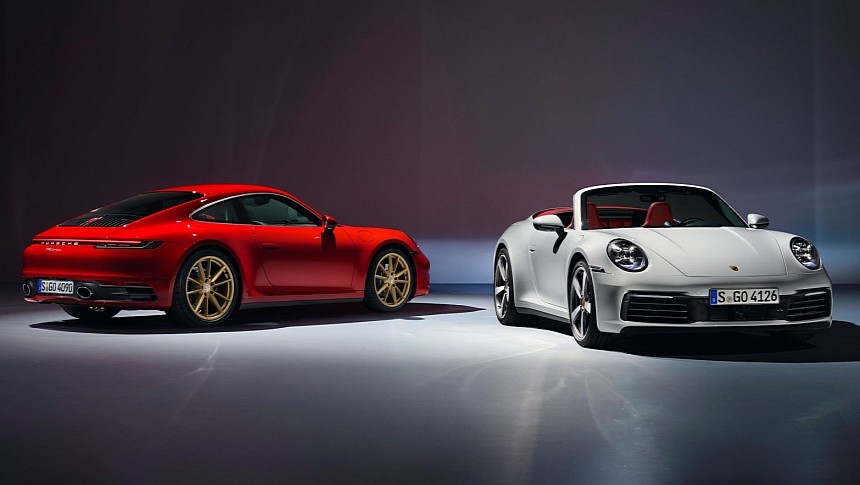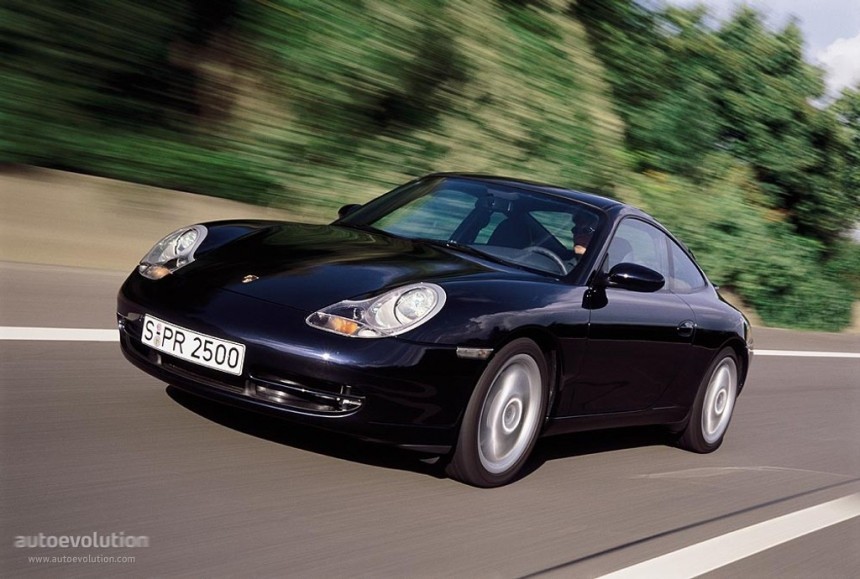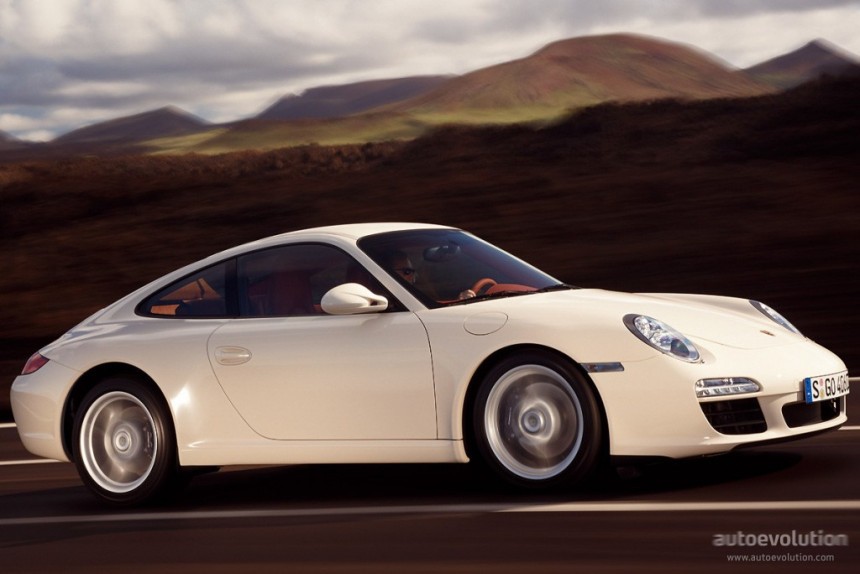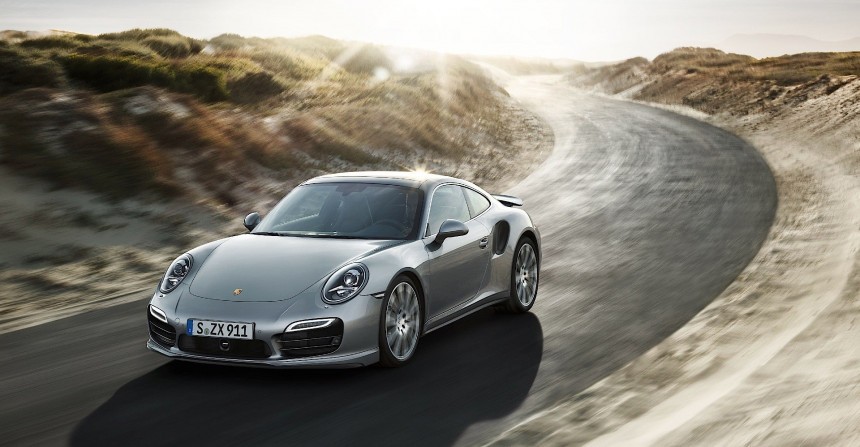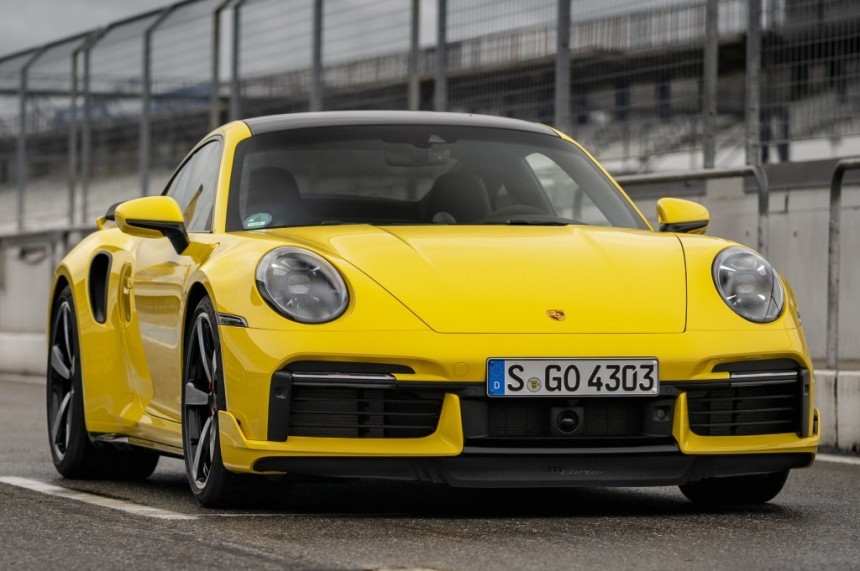For a lot of Porsche fans, the 911 saga can be divided into two distinct eras – the days of air cooling which ended in 1998 and the liquid-cooled epoch that followed. To say this change was controversial would be a bit of an understatement, as the air-cooled boxer engines used up until then came to represent an integral part of the 911's character.
Despite numerous people frowning upon the automaker’s switch to liquid cooling, we’ll have to look at things realistically and consider this: an outdated technology can only be milked and refined to a certain extent before it starts putting some serious constraints on performance. There was just no way for Porsche’s flagship sports car to continue employing yesterday’s tech and remain relevant as the turn of the century approached.
Thus, the contentious decision had to be made sooner or later, and the nameplate’s fifth generation – the 996 – is when it finally happened. We’ve covered the air-cooled years from the 911’s inception to the fan-favorite 993-gen in a previous article, one which you should absolutely check out if you haven’t already! Today, it’s time for part two, boys and girls, so tag along as we analyze how the P-car has evolved over the last two and a half decades.
Picking up where we left off, the German marque debuted its all-new 996 in 1997, and we’ve already mentioned the adoption of water cooling as one of its stand-out features. There was a lot more to it than that, though, and much of the design process had been dictated by the grim financial situation Porsche was in at the time.
A fellow named Pinky Lai came up with the original concept for the car’s exterior around 1993, but his vision would undergo some radical alterations before hitting the assembly line a few years later. For instance, Pinky’s design had oval headlamps separated from the turn signals – just like previous 911s – and a lack of funds for development led to these being merged together.
Due to their shape and orange blinkers, the restyled assemblies came to be known as fried egg headlights; a polarizing setup at first, yet one that grew on many aficionados over time. The 996 was also larger, more rounded, and about 50 kg or 110 pounds lighter than its predecessor, using a stiffer chassis that was pretty much engineered from the ground up.
In terms of equipment, it shared numerous components with the entry-level Boxter introduced earlier on (aka the 986), all with the aim of cutting costs wherever possible. The car’s front suspension arrangement and several interior goodies were among these parts, while its engine was basically just an enlarged version of the 986’s powerhouse. Such similarities are said to have enabled the company to save as much as 30 percent in development costs.
Up until 2002, naturally aspirated 996s rolled off the production line bearing 24-valve, 3.4-liter flat-six mills, which could be paired with your choice of a six-speed manual or a five-speed automatic. Both rear- and all-wheel drive were once again offered, while the P-car's factory-rated output peaked at a respectable 300 ponies.
The updated 911 Turbo landed in the year 2000 as a 2001 model, feeding all four wheels with up to 420 hp from its 3.6-liter twin-turbocharged engine. That same year, Porsche introduced a GT2 variant sporting ceramic brakes to the 996 line, but the earlier GT3 of ‘99 is also worth mentioning. As a successor to the 993-gen Carrera RS, this thing was essentially a street-legal race car with 360 horses on tap.
For 2002, Stuttgart's auto giant blessed the naturally aspirated 911s with a larger 3.6-liter powerplant making an additional 15 hp. Just under 180,000 copies were sold during the 996’s production run, which lasted until 2004 for the base models and 2006 for the high-end Turbo S, GT2, and GT3 versions.
The nameplate's sixth generation, the 997, was revealed in July 2004, bringing back the iconic circular headlights and separate blinkers we've last seen on the 993. Eighteen-inch wheels were now provided as standard equipment, the rear bodywork became approximately 3.5 inches (90 mm) wider than the 996’s, and customers could either go for the standard Carrera trim or the higher-spec Carrera S.
The former came with a 3.6-liter M96 mill like that of its forerunner, this time tuned to 325 hp. On the other hand, the Carrera S got a 3.8-liter flat-six codenamed M97 and it therefore benefited from a factory-rated output of 355 stout German stallions. Deliveries for the all-wheel drive 997s began during the fall of 2005, and these were available in the same configurations as their RWD counterparts.
Features like improved brakes, 19-inch wheels, and lowered suspension with Porsche’s Active Suspension Management system also made their way onto the S-badged cars. Those seeking some boost in their lives got the honor of meeting the 997 Turbo for the first time at the 2006 Geneva Motor Show, where it appeared alongside the new, 415-hp GT3 homologation special.
By comparison, the Turbo was good for up to 480 Teutonic steeds and could dash from zero to 62 mph (100 kph) in about three and a half seconds. As if that wasn’t enough power, the updated GT2 hit the shelves in 2007 with a cavalry numbering 530 ponies at its disposal. Come September 2008, Porsche gave the sixth-gen 911 a comprehensive overhaul, consequently spawning what is unofficially referred to as the 997.2.
Direct fuel injection, a redesigned front bumper with bigger air inlets, and some extra grunt were a few of the upgrades, while the dual-clutch transmission known as PDK became available as a fresh drivetrain option. After selling about 215,000 units of the 997-gen, the Germans decided it was time to move on in 2011 and presented the sports car’s seventh iteration at the Frankfurt Motor Show.
If you’re Porsche, the number 991 comes after 997, and so the vastly improved seventh-gen 911 became known as the 991. Why? Because logic is for normies, that’s why. The updated version gained a brand-new chassis, fatter tires, and increased track width, as well as a longer wheelbase and better weight distribution to aid with stability.
However, engine capacity went down on the entry-level Carreras for the first time in the vehicle’s history, from 3.6 to 3.4 liters. Power output still grew by around five horses, nonetheless, and the Carrera S retained its 3.8-liter displacement with a peak output numbering 394 ponies. The AWD and turbocharged 991s saw the light of day in 2012, with the ability to spawn a brutal 560 hp in the case of the Turbo S.
An interesting change could be found on the Targa body style, which had done away with the original roll hoop design and removable top in the mid-nineties. The nostalgic pre-993 roll bar returned on the 991, incorporating an electronically controlled glass roof mechanism somewhat similar to that of the 997. Oh, and even though Porsche was busy adding more gears to the lineup by way of a seven-speed manual, downsizing would persist in the engine bay.
The model-year 2016 meant a mid-cycle refresh for the legendary P-car, giving its lower-ranking configurations a twin-turbocharged three-liter engine. On the Carrera GTS, for instance, this powerhouse could result in up to 450 hp and 406 pound-feet (550 Nm) of torque – enough to propel you from zero to 60 mph (96 kph) in 3.9 seconds when paired with a manual, and a mere 3.5 ticks with the PDK.
A huge milestone came in 2017, when the company’s one millionth 911 – a Carrera S finished in a special Irish Green colorway – rolled off the assembly line. This specimen is currently being held at the Porsche Museum in Stuttgart, and you can be certain that it’ll fetch an absolute fortune if it ever ends up hitting the auction block.
On November 27, 2018, the world got its first glimpse of the eighth- and current-gen 911, the 992, at the Porsche Experience Center in L.A. It was once again wider than its predecessor, flaunting restyled front and rear bumpers, pop-out door handles, and several interior changes such as a straighter dash reminiscent of vintage models.
Base variants can extract between 380 to 473 hp from their twin-turbocharged, three-liter boxers, while the Turbo and Turbo S iterations use 3.7-liter engines to muster 572 and 641 stallions, respectively. In coupe form, the unrelenting Turbo S is capable of hitting 62 mph (100 kph) from a standstill in just 2.7 seconds, and it’ll continue accelerating to a 205-mph (330 kph) top speed if prompted. By all accounts, these are supercar numbers!
Unlike many other supercars, though, Porsche’s offerings are actually easy to live with on a day-to-day basis thanks to their practical nature. They still pack all the thrills you could want from such high-performance machines, and cost significantly less than a lot of direct competitors while doing so.
Then you’ve got beasts like the 992 GT3 RS, which lapped the Nürburgring Nordschleife last year in a bonkers six minutes and 44.848 seconds – just over a tenth of a second faster than the Lamborghini Aventador SVJ LP770-4. Now, we haven’t even had a chance to cover the P-car's racing successes or the numerous special editions released over the years, and Porsche’s motorsport ventures by themselves would probably be worthy of a standalone article.
Besides that, talking about this model’s extensive history and its eight generations can get very confusing for those who aren’t yet familiar with the lore, so let’s keep things relatively simple and call it a day, alright? With all that being said, we think (and certainly hope) the 911 will stick around and push the sports car envelope for a long time to come. The prospect of electrification is a little stressful, for sure, but at least we don’t have to worry about such horrors just yet.
Thus, the contentious decision had to be made sooner or later, and the nameplate’s fifth generation – the 996 – is when it finally happened. We’ve covered the air-cooled years from the 911’s inception to the fan-favorite 993-gen in a previous article, one which you should absolutely check out if you haven’t already! Today, it’s time for part two, boys and girls, so tag along as we analyze how the P-car has evolved over the last two and a half decades.
Picking up where we left off, the German marque debuted its all-new 996 in 1997, and we’ve already mentioned the adoption of water cooling as one of its stand-out features. There was a lot more to it than that, though, and much of the design process had been dictated by the grim financial situation Porsche was in at the time.
A fellow named Pinky Lai came up with the original concept for the car’s exterior around 1993, but his vision would undergo some radical alterations before hitting the assembly line a few years later. For instance, Pinky’s design had oval headlamps separated from the turn signals – just like previous 911s – and a lack of funds for development led to these being merged together.
In terms of equipment, it shared numerous components with the entry-level Boxter introduced earlier on (aka the 986), all with the aim of cutting costs wherever possible. The car’s front suspension arrangement and several interior goodies were among these parts, while its engine was basically just an enlarged version of the 986’s powerhouse. Such similarities are said to have enabled the company to save as much as 30 percent in development costs.
Up until 2002, naturally aspirated 996s rolled off the production line bearing 24-valve, 3.4-liter flat-six mills, which could be paired with your choice of a six-speed manual or a five-speed automatic. Both rear- and all-wheel drive were once again offered, while the P-car's factory-rated output peaked at a respectable 300 ponies.
The updated 911 Turbo landed in the year 2000 as a 2001 model, feeding all four wheels with up to 420 hp from its 3.6-liter twin-turbocharged engine. That same year, Porsche introduced a GT2 variant sporting ceramic brakes to the 996 line, but the earlier GT3 of ‘99 is also worth mentioning. As a successor to the 993-gen Carrera RS, this thing was essentially a street-legal race car with 360 horses on tap.
For 2002, Stuttgart's auto giant blessed the naturally aspirated 911s with a larger 3.6-liter powerplant making an additional 15 hp. Just under 180,000 copies were sold during the 996’s production run, which lasted until 2004 for the base models and 2006 for the high-end Turbo S, GT2, and GT3 versions.
The former came with a 3.6-liter M96 mill like that of its forerunner, this time tuned to 325 hp. On the other hand, the Carrera S got a 3.8-liter flat-six codenamed M97 and it therefore benefited from a factory-rated output of 355 stout German stallions. Deliveries for the all-wheel drive 997s began during the fall of 2005, and these were available in the same configurations as their RWD counterparts.
Features like improved brakes, 19-inch wheels, and lowered suspension with Porsche’s Active Suspension Management system also made their way onto the S-badged cars. Those seeking some boost in their lives got the honor of meeting the 997 Turbo for the first time at the 2006 Geneva Motor Show, where it appeared alongside the new, 415-hp GT3 homologation special.
By comparison, the Turbo was good for up to 480 Teutonic steeds and could dash from zero to 62 mph (100 kph) in about three and a half seconds. As if that wasn’t enough power, the updated GT2 hit the shelves in 2007 with a cavalry numbering 530 ponies at its disposal. Come September 2008, Porsche gave the sixth-gen 911 a comprehensive overhaul, consequently spawning what is unofficially referred to as the 997.2.
Direct fuel injection, a redesigned front bumper with bigger air inlets, and some extra grunt were a few of the upgrades, while the dual-clutch transmission known as PDK became available as a fresh drivetrain option. After selling about 215,000 units of the 997-gen, the Germans decided it was time to move on in 2011 and presented the sports car’s seventh iteration at the Frankfurt Motor Show.
However, engine capacity went down on the entry-level Carreras for the first time in the vehicle’s history, from 3.6 to 3.4 liters. Power output still grew by around five horses, nonetheless, and the Carrera S retained its 3.8-liter displacement with a peak output numbering 394 ponies. The AWD and turbocharged 991s saw the light of day in 2012, with the ability to spawn a brutal 560 hp in the case of the Turbo S.
An interesting change could be found on the Targa body style, which had done away with the original roll hoop design and removable top in the mid-nineties. The nostalgic pre-993 roll bar returned on the 991, incorporating an electronically controlled glass roof mechanism somewhat similar to that of the 997. Oh, and even though Porsche was busy adding more gears to the lineup by way of a seven-speed manual, downsizing would persist in the engine bay.
The model-year 2016 meant a mid-cycle refresh for the legendary P-car, giving its lower-ranking configurations a twin-turbocharged three-liter engine. On the Carrera GTS, for instance, this powerhouse could result in up to 450 hp and 406 pound-feet (550 Nm) of torque – enough to propel you from zero to 60 mph (96 kph) in 3.9 seconds when paired with a manual, and a mere 3.5 ticks with the PDK.
A huge milestone came in 2017, when the company’s one millionth 911 – a Carrera S finished in a special Irish Green colorway – rolled off the assembly line. This specimen is currently being held at the Porsche Museum in Stuttgart, and you can be certain that it’ll fetch an absolute fortune if it ever ends up hitting the auction block.
Base variants can extract between 380 to 473 hp from their twin-turbocharged, three-liter boxers, while the Turbo and Turbo S iterations use 3.7-liter engines to muster 572 and 641 stallions, respectively. In coupe form, the unrelenting Turbo S is capable of hitting 62 mph (100 kph) from a standstill in just 2.7 seconds, and it’ll continue accelerating to a 205-mph (330 kph) top speed if prompted. By all accounts, these are supercar numbers!
Unlike many other supercars, though, Porsche’s offerings are actually easy to live with on a day-to-day basis thanks to their practical nature. They still pack all the thrills you could want from such high-performance machines, and cost significantly less than a lot of direct competitors while doing so.
Then you’ve got beasts like the 992 GT3 RS, which lapped the Nürburgring Nordschleife last year in a bonkers six minutes and 44.848 seconds – just over a tenth of a second faster than the Lamborghini Aventador SVJ LP770-4. Now, we haven’t even had a chance to cover the P-car's racing successes or the numerous special editions released over the years, and Porsche’s motorsport ventures by themselves would probably be worthy of a standalone article.
Besides that, talking about this model’s extensive history and its eight generations can get very confusing for those who aren’t yet familiar with the lore, so let’s keep things relatively simple and call it a day, alright? With all that being said, we think (and certainly hope) the 911 will stick around and push the sports car envelope for a long time to come. The prospect of electrification is a little stressful, for sure, but at least we don’t have to worry about such horrors just yet.
